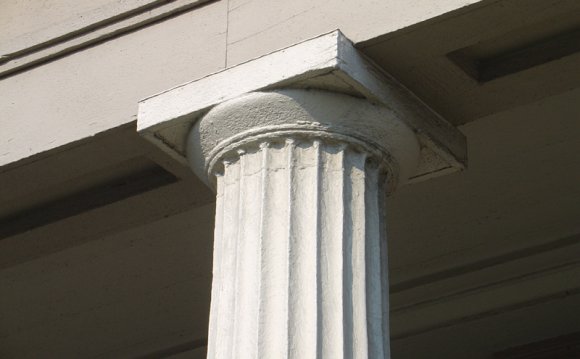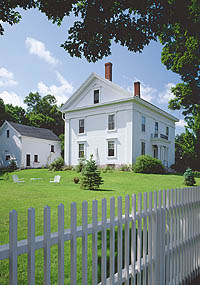
 |
|
| In rural areas and later years, reduced expression of the Greek Revival often looked like the Captain Charles Wordin House in Belfast, Maine: two-or four-column entry porch, less than the full height or width of the house, pilastered corners, and a pronounced cornice. Photo Courtesy of Brian Vanden Brink | |
Or how about this: A small white farmhouse in Ohio with a front-facing gable, attached pilasters at the front corners, a deep, unornamented fascia board, and a rectangular transom and sidelights at the front door? Or a tall and narrow brick town house in New York with a tiny, columned porch, a side-hall plan, and a parade of small rectangular windows just below the cornice?
You couldn't go wrong with any of these optionsÑthey're all good examples of Greek Revival architecture in AmericaÑbut there's no question that the less ostentatious second and third versions far outnumber the Taras. From the 1820s until the Civil War, Greek Revival was a one-style-fits-all building design choice of rich and poor, in town and country, North and South, from the Atlantic Ocean to the new Midwest and around the Cape to California. There were regional variations, to be sure, and these help to make house-gazing a continuing pleasure in all these regions.
Ancient Architecture Reinvented
Americans of the early 19th century saw several good reasons for adapting at least some aspects of Greek classicism to their own houses, churches, and public buildings. For starters, Greece's struggle for independence from Turkey was at its height in the 1820s, reminding Americans of their own hard-won sovereignty. Greece, the world's first democracy, seemed an appropriate philosophical reference point for a self-confident new republic. Plus, with its air of antiquity, Greek Revival architecture brought a sense of permanence and solidity to the spanking-new American landscape. Its very austerity proclaimed the sturdy self-reliance of a nation that was pushing westward with all its might, conquering new frontiers at the same time it was trying to establish its cultural credentials with the Old World.
Not that Americans were interested in re-creating an archeologically pure form of Greek architecture. While they admired the austere beauty of Greece's post-and-lintel buildings, their practical minds insisted on buildings that used 19th-century technology and accommodated 19th-century lifestyles. They were in search of a National Style of architecture reflecting their own time and placeÑone that would represent America's abundance and energy as well as its political and cultural ideals. They wanted a style that betokened a glorious future as well as a glorious past. The Greek example, properly modified, seemed to fit their needs.
Although the details varied from region to region and from one economic stratum to another, the general characteristics of this new-old style include simplicity, as well as an emphatic rectilinear geometry and insistent symmetry of form.
RELATED VIDEO












